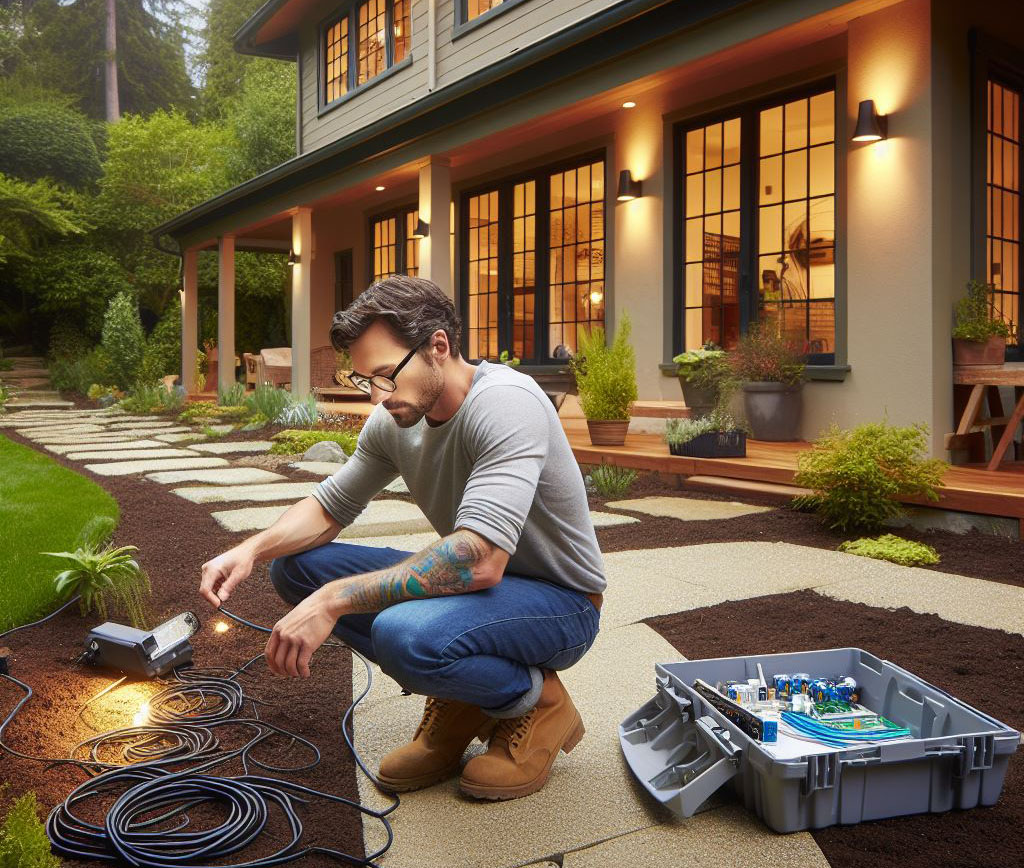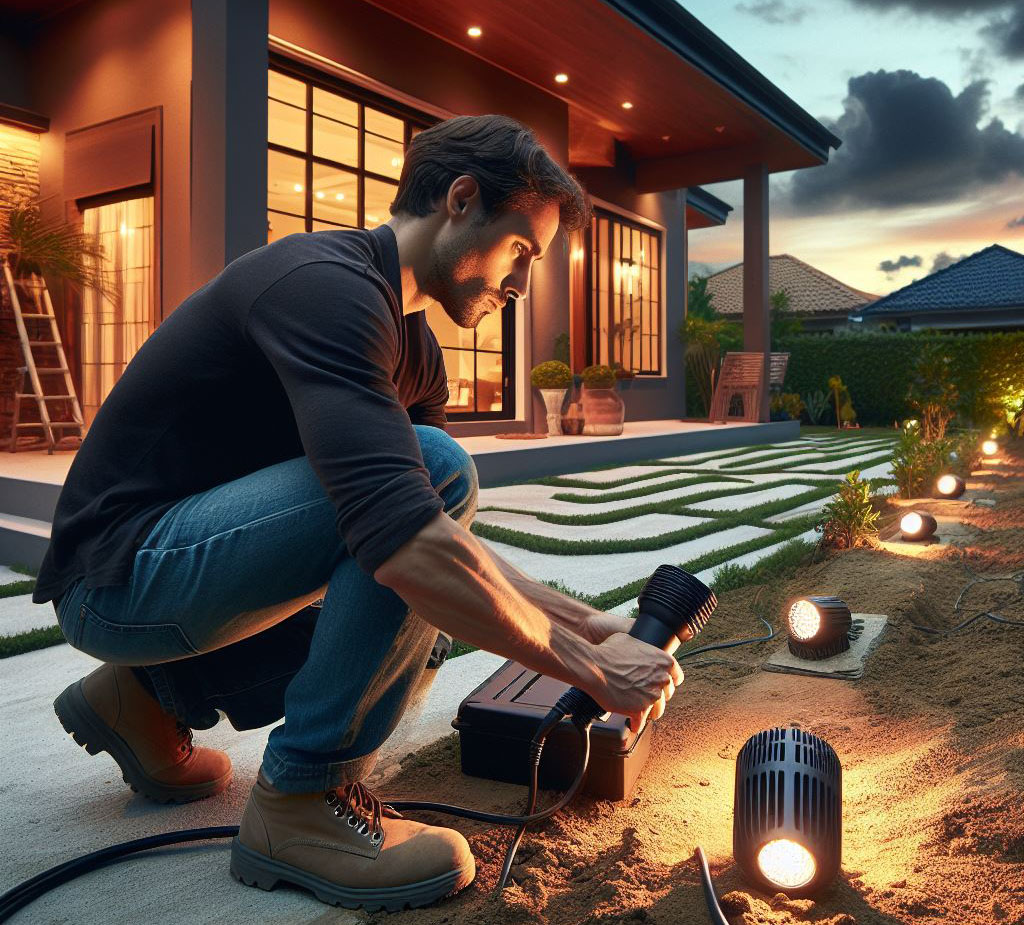Embarking on the journey of landscape lighting installation is not just about enhancing the visual appeal of your property—it’s a strategic move to elevate safety and ambiance. This guide is designed to serve the ambitious DIY enthusiasts as well as the dedicated, self-employed professionals in home improvement. It’s about marrying aesthetics with practicality, ensuring every step is both functional and visually compelling.

Planning Your Landscape Lighting Project
Precision planning is the cornerstone of a successful landscape lighting project. It’s about creating harmony between functionality and aesthetics. Let’s break it down:
- The Master Plan: Approach your landscape as a canvas. Use graph paper to sketch your vision, pinpointing key features like trees, architectural elements, or paths. It’s about creating a roadmap, ensuring every light has a purpose, enhancing safety, and accentuating beauty.
- Light ‘Em Up Choices:
- Path Lights: Ideal for safety and guiding steps, these should be placed thoughtfully to illuminate walkways, not overpower them.
- Spotlights: Perfect for drawing the eye to specific elements, creating depth, and adding drama to the landscape.
- Accent Lights: These are your tools for subtlety, adding gentle touches of light to features you want to softly highlight.
- Picking Your Fireflies:
- LED: Efficiency meets longevity. These are the workhorses of landscape lighting, offering sustainability without sacrificing brightness.
- Solar: For the eco-conscious, these lights harness the sun’s power, reducing energy consumption and ensuring ease of installation.
- Halogen: The traditional choice, known for their brightness and warmth, but requiring more energy and emitting more heat.

Understanding the Basics of Outdoor Electrical Safety
When electricity is involved, meticulousness is non-negotiable. It’s about ensuring longevity and safety in every connection and component.
- Safety Gear Up: Equip yourself appropriately. Insulating gloves and footwear are fundamental to safeguard against the unpredictability of working with electricity outdoors.
- Code Red: Familiarize yourself with local building codes. Compliance is key—not just for legality but for ensuring the longevity and safety of your installation.
- Waterproofing: Outdoor elements are unforgiving. Ensure every connection is watertight, using junction boxes and opting for secure seals like waterproof wire nuts or heat shrink tubing.

Choosing the Right Type of Landscape Lighting
Selecting the ideal landscape lighting is akin to selecting the perfect set of tools for a crucial project. Each light type serves a distinct purpose, harmonizing aesthetics with functionality to create an inviting and safe outdoor environment.
- Floodlights vs. Spotlights: Floodlights are your go-to for expansive illumination, casting a wide glow perfect for driveways or large garden areas. Spotlights, on the other hand, are the precision tools in your lighting toolkit, allowing you to focus attention on specific landscape features, much like a painter adding highlights to a masterpiece.
- Path Lights: Essential for safety and navigation, path lights guide visitors along walkways and steps. Their gentle illumination ensures safe passage, while also enhancing the beauty of your garden paths.
- Accent Lights: These subtle yet impactful lights add layers of depth and interest to your outdoor space. Use them to softly highlight architectural details or garden elements, adding a touch of elegance to the nighttime landscape.
When considering the atmosphere you want to create, color temperature and brightness play pivotal roles:
- Color Temperature: This aspect is crucial in setting the mood. A warmer color temperature (2700K to 3000K) creates a welcoming and intimate ambiance, ideal for most gardens and outdoor spaces.
- Brightness: Measured in lumens, the brightness level should be chosen with care. Overly bright lights can overwhelm and detract from the beauty of your outdoor space. Opt for a balanced approach that enhances visibility while preserving the natural charm of your garden at night.

Installation Process
The installation of landscape lighting should be approached with meticulous planning and precision execution. Here’s a detailed guide to ensure a smooth and successful installation:
- Setting Up the Transformer: This crucial component is the lifeblood of your landscape lighting system. It’s essential to choose a transformer with adequate capacity, generally leaving a 20% buffer to prevent overloading. Mount it near a GFCI outlet for safety and ease of access.
- Laying Out the Cables: Precision is key in this step. Adhere to your planned layout, burying the cables at a depth of around 6 inches to protect them from gardening activities and ensure their longevity.
- Connecting Lights to the Power Source: Ensure every connection is secure and moisture-resistant. Opt for high-quality connectors specifically designed for outdoor use, and meticulously seal each connection to protect against the elements.
- Securing Fixtures: Stability is paramount. Install each light fixture firmly to withstand natural elements and incidental contact. Take the time to ensure each light is properly anchored and aligned with your design intentions.
- Adjusting Angles and Positions: The final touch involves fine-tuning each light for optimal effect. Adjust the angles and positions to highlight the desired features, crafting a cohesive and inviting outdoor atmosphere.
Troubleshooting Common Issues
In the realm of landscape lighting, even the most meticulously installed systems can encounter issues. Here’s how to address the usual suspects, drawing from years of hands-on experience:
- Flickering Lights: A common nuisance that’s often rooted in loose connections. Methodically check each connection point – bulbs, fixtures, and wires. If the flicker persists, consider the possibility of voltage drop, especially if your wiring runs are lengthy, and consult your voltage chart to troubleshoot further.
- Non-Functioning Bulbs: Start with the basics: ensure the bulb is securely fitted and the power source is active. Employ a multimeter to check for continuity. If the bulb has burned out, replace it, keeping an eye on compatibility and wattage to prevent recurring issues.
- Exposed Wiring: This is more than just an eyesore, it’s a potential hazard. Don protective gear and remedy any exposed wiring immediately. Replace or properly insulate the affected area, ensuring your system’s integrity and safety.
Regular maintenance is not just about functionality but also about preserving the charm and longevity of your lighting. Keep fixtures clean, manage foliage to prevent obstruction, and routinely inspect for signs of wear or damage.
Advanced Tips and Tricks
Elevate your landscape lighting from functional to phenomenal with these advanced strategies, combining aesthetic finesse with technological savvy:
- Setting the Scene: Think of your garden as a stage. Use lighting to define spaces, creating distinct ambiences in different areas. Be it a serene, softly lit reading corner or a vibrant, spotlighted display of your horticultural achievements.
- Smart Systems: Embrace the era of smart technology. Integrate your lighting with a smart controller for unparalleled convenience and control. Imagine adjusting settings from your device, or better yet, having your system adapt automatically to environmental changes or schedules.
- Energy Efficiency: Commit to efficiency with LEDs. Their low power consumption and longevity make them an ideal choice. Pair them with motion sensors for presence-based illumination and timers to ensure lights are used only when necessary, reducing waste and saving energy.
FAQ Section
Calculate the total wattage of your lights and select a transformer that exceeds this number by at least 25%. This buffer ensures reliability and accommodates any future additions to your lighting landscape.
Certainly. Timers are an excellent tool for managing your lighting efficiently, providing the convenience of automated control while conserving energy.
Opt for LED lights for their energy-efficient nature. Enhance their effectiveness with dimmers, sensors, and timers, ensuring your lights are active only when needed, further conserving energy.
Regular maintenance is key. Keep fixtures clean and free of debris, routinely check connections and wiring, and promptly replace any failed bulbs. These simple steps can significantly extend the life and performance of your lighting system.
